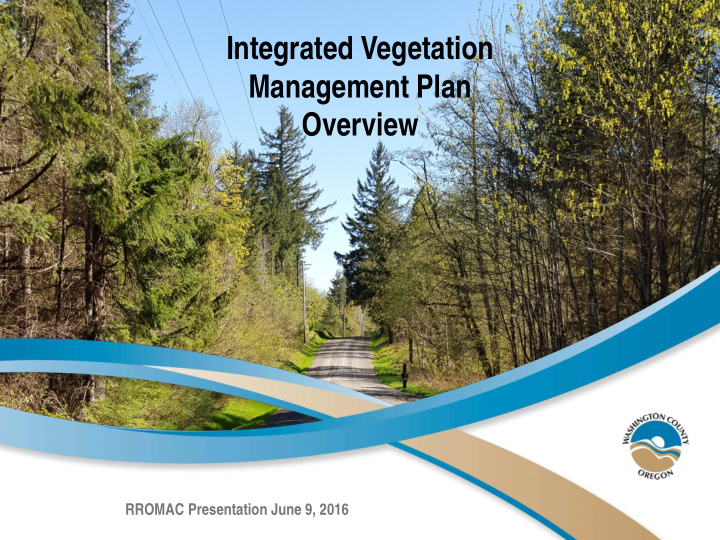



Integrated Vegetation Management Plan Overview RROMAC Presentation June 9, 2016
Components of IVMP • Introduction • Right-of-way Maintenance Zones and Management Methods • Managing Vegetation of Concern • Herbicide Application • Monitoring, Evaluation, and Reporting • Protected Species in Washington County “The IVM approach combines maintenance and management practices to create a coordinated strategy to achieve long-term roadside maintenance goals in an environmentally and fiscally responsible manner. A suite of practices (mechanical, cultural, chemical, and biological), along with program monitoring and evaluation, are carried out to achieve these goals.”
Roadside Vegetation Management Zones
County Management Methods Management Method Mechanical Chemical Cultural Biological Zone 1: Mow with a shoulder mower or Apply a combination of post- and Provide weed-free erosion Not usually considered in Pavement brush cutter. pre-emergent herbicide in April, control products during this zone. Edge May, or June. construction. Remove vegetation mats and debris buildup with a backhoe, Apply a second application of pre- Do not plant vegetation in this excavator, grader, scraper, or emergent herbicide in September zone. sweeper while carrying out or October for year-round growth associated maintenance activities. suppression. Zone 2: Mow a single swath adjacent to Broadcast spray with selective Seed and plant disturbed areas Work with ODA to initiate Operational Zone 1 with a brush cutter to herbicides to target areas of with native or naturalized the use of biological maintain visibility of signs and nuisance and noxious weeds and vegetation appropriate for controls on problematic utilities. Zone 2. vegetation in the right-of- aggressively growing problematic vegetation. way. Use a combination of brush cutter Plant sites in late winter and and hand tools to selectively Spot treat individual weeds with hydroseed in spring and fall remove unwanted trees and shrubs backpack sprayers and injectors to based on temperature and beyond the mowing strip. moisture to maximize survival minimize harm to neighboring vegetation. potential. Hydroseed disturbed ditches with native or naturalized grasses. Use weed-free erosion and sediment control products on construction sites. Zone 3: Use hand tools to remove or trim Use the same Chemical Use the same Cultural Use the same Biological Buffer problematic trees or shrubs. Management Methods as Zone 2. Management Methods as Zone Management Methods as 2. Zone 2.
Zone Management Examples
Questions?
Recommend
More recommend